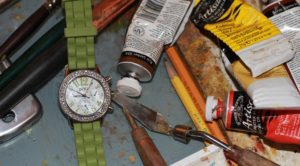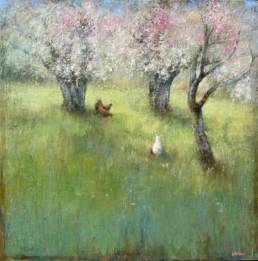 Not all artists are able to devote themselves to their art fulltime. In fact, it is not uncommon to find many aspiring and professional artists struggling to attain a balance between a steady paycheck and managing the time and energy to create.
Not all artists are able to devote themselves to their art fulltime. In fact, it is not uncommon to find many aspiring and professional artists struggling to attain a balance between a steady paycheck and managing the time and energy to create.
I know how this feels. As a stay-at-home-mom, my own art career slowly developed within the short studio moments I could steal during my children’s naptime and in between loads of laundry. But believe it or not, I was still able to produce some good art back in those days. Below, is the first article in a short series that I will be posting on time management skills for the artist. Here you will find some great tips to help you use small intervals of creative time in productive ways.
Boost Art Productivity with Short Studio Sessions
Guest author: Originally posted on ArtBistro.Monster.com
If, like many artists, you find it hard to secure sizable chunks of time to paint—and even if those large chunks are available to you—it is good to get clever at organizing your mind, your equipment, and your life so as to make the best use possible of those small chunks of time that fly by each day.
Carving out those longer painting periods of course remains essential, because creating requires extensive and concentrated intervals of work. So you have the ongoing job of finding the way to create those substantial painting periods. But small chunks of time can have significant value if you get in the habit of using them well.
Here are four tips for using small intervals of time in productive ways:
 1. Have a Clear Idea: Get in the habit of knowing what your current painting needs, so that you can return to it with an internal understanding that you are “turning directly to the left arm” or “working on that second rose from the right.” By maintaining a clear sense of what you intend to tackle next, you avoid procrastination and you find the motivation to turn to your painting even though you only have a few minutes at your disposal. Naturally, such clarity isn’t always available. But it is available more often that we suspect if we train ourselves to be open to it.
1. Have a Clear Idea: Get in the habit of knowing what your current painting needs, so that you can return to it with an internal understanding that you are “turning directly to the left arm” or “working on that second rose from the right.” By maintaining a clear sense of what you intend to tackle next, you avoid procrastination and you find the motivation to turn to your painting even though you only have a few minutes at your disposal. Naturally, such clarity isn’t always available. But it is available more often that we suspect if we train ourselves to be open to it.
2. Less is More: Create some projects that lend themselves to being worked on in small increments. Maybe your central or major works can’t be divided up neatly and maybe they require the kind of attention and concentration that only long painting periods afford. Still, mightn’t it be possible to create some secondary or smaller projects that lend themselves to being worked on for fifteen minutes or thirty minutes at a time? If it is, then over time you’ll complete many additional works and do a nice job of building your inventory.
3. Unplug: In order to make use of these small chunks of time as they arise, we have to break our habit of routinely and reflexively turning to one of our “distraction addictions” to while away those minutes. As a matter of routine, and without thinking about it, people nowadays check their email, browse the news online, turn to Facebook or Twitter, catch up on one or another of their Internet games, or do something else Web-based so as to “get rid of” those few minutes. Until we break that habit, there is little chance that we can make productive use of the fifteen or thirty minutes that become available to us throughout the day.
4. Do not Procrastinate: We need to remind ourselves just how quickly certain things can be accomplished. How long does it take to write a two-line email to someone who might help to grow your art business? Typically people hold this to be a huge task because anxiety wells up in them when they think about putting themselves “out there.” But the reality is that the email itself takes hardly a minute or two to write and a microsecond to send. If you learn to calm yourself, center yourself, and not magnify the risk involved, you could make significant headway every time you found a few minutes at your disposal.
In an ideal world we might find ourselves doing less scrambling. For most of us, however, the reality is that our days are choppy and jagged and that bits of time suddenly arrive — and vanish. It isn’t that we have to grab every one of those fleeting intervals and make use of it. By the same token, though, we do want to grab a lot of them — as they may be the only time we have available.
*****
Good luck with boosting your own art productivity during short studio sessions. Stay tuned for some more time management tips in the coming weeks. If you have any time management or studio tips you would like to share, please leave a comment. We all learn from each other! ~Lori
PS. Let’s meet on Facebook and Twitter! And please check out LoriMcNee.com to see my paintings!
You might like to read a few of these helpful posts:
The Healthy Artist: Tips to Help You Stay that Way
Artistic Temperament: What to Do When it Strikes!
How to Jump-Start Your Art Career
10 Ways to Overcome Mental Blocks & Boost Creativity
Feeling Unproductive in the Studio or Office? How to Combat Spring Fever










Hi Lori, You are right on here. I have a full time career in education and have stuggled this last year with a huge growth in my enthusiasm for artwork and learning verses my available time. So, I decided in December to devote small chunks. It forced me to be very organized. During the day when I get a moment, I decide what my painting subject will be and for two hours at night, I paint or sketch. I have been very productive and it really works. Every evening M-F I get in another 10 hours of painting. I paint on the weekends and this really adds up to over 20 hours of week. I got the idea initially from Marc Hansen. A FB friend of his thanked him for suggesting a painting schedule and I started thinking that I needed to set a pace for myself. Even when I am tired, I take time to do a little. Funny thing is when I’m tired and start, somehow I get renewed energy. I suggest anyone who is seeking more painting time, etch out some small niche and be consistant. It really works.
Hello Susan-
Great tips Susan. I use to get a lot accomplished by doing small chunks of time. Now, that my kids are all older, I should have more time to paint…but, blogging and social media are eating up a lot of my painting time! So, I am having to go back to smaller studio sessions again. It is working though. Thanks for sharing your story and comment. Great seeing you here. Marc is a fun FB friend, isn’t he?
Best-
Lori
Hi Lori, Great article and a great inspiration to artists with little time. Would you mind if i put this in our monthly newsletter with a link to your Fine art tips blog. Let me know, I have to get it out this week. If this is ok, and you don’t mind, I will send you a copy as soon as it is done. Kind Regards,
Sam
Hi Sam-
I apologize for the belated reply. I have been extra busy this week and behind on my blog and social media – for shame!!! Yes, you are welcome to use this article. I am glad you like it and thanks for asking. Please link to the original article on my site.
Thanks again- and great seeing you here…
Lori
Lori, these are great tips. I’m not an artist, but I will try to apply these principles to my guitar practice. One tool that I use for small increments is a digital timer. Before I wouldn’t even think about sitting down with my guitar for less than 30 minutes. For some reason, when I got a digital timer, I’d set it for ten minutes — and it would keep me focused for the practice session. For some reason, just having the timer justified the 10-minute session. All in my head, I guess, but you’re article seemed to confirm what I discovered — short sessions can be productive.
I also record my micro-session time, because I usually shoot for a daily quota of practice.
Regards,
Jim
Good to read this article again for the reinforcement of a key idea!
I’ve also found that living in a tiny apartment helps keep my work from stagnating. Tip #1 almost cannot be avoided in this case as I’m constantly walking past whatever is on my easel. Every time I see my current painting I’m zeroing in on what specific area needs work next. Having my work space almost ‘in my way’ does wonders for motivation!
Best,
Becky
Glad this post reinforced your creative flow. Yes, it is tough to ignore something that you see all the time! That is why I like having my studio in my home. There are less excuses!
Wonderful post. My take away from this is where you mentioned that we should always try to remind yourself how quickly certain things can be done. It true! Some things literally take 2 minutes and those two minutes could be the life or death of a potential deal. Thanks again!!! So insightful. Check out my WP blog Adrian’s Art Creations.
Hello Adrian, I’ll check out your site and thanks for visiting and commenting on mine. I’m glad you enjoyed this post! I think I should re-read it myself – haha!